MSI Z97 Gaming 5 Motherboard Review: Five is Alive
by Ian Cutress on October 6, 2014 10:00 AM EST- Posted in
- Motherboards
- Intel
- MSI
- Z97
System Benchmarks
Power Consumption
Power consumption was tested on the system while in a single MSI GTX 770 Lightning GPU configuration with a wall meter connected to the OCZ 1250W power supply. This power supply is Gold rated, and as I am in the UK on a 230-240 V supply, leads to ~75% efficiency > 50W, and 90%+ efficiency at 250W, suitable for both idle and multi-GPU loading. This method of power reading allows us to compare the power management of the UEFI and the board to supply components with power under load, and includes typical PSU losses due to efficiency. These are the real world values that consumers may expect from a typical system (minus the monitor) using this motherboard.
While this method for power measurement may not be ideal, and you feel these numbers are not representative due to the high wattage power supply being used (we use the same PSU to remain consistent over a series of reviews, and the fact that some boards on our test bed get tested with three or four high powered GPUs), the important point to take away is the relationship between the numbers. These boards are all under the same conditions, and thus the differences between them should be easy to spot.
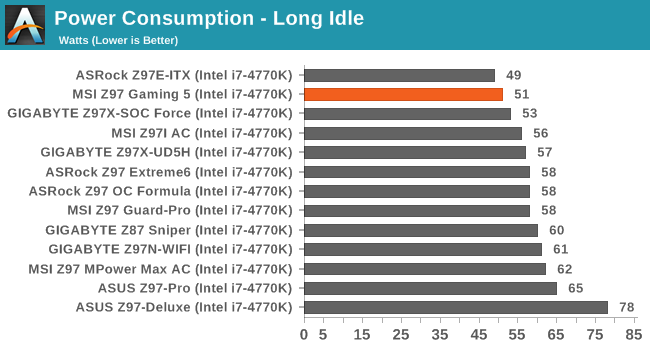
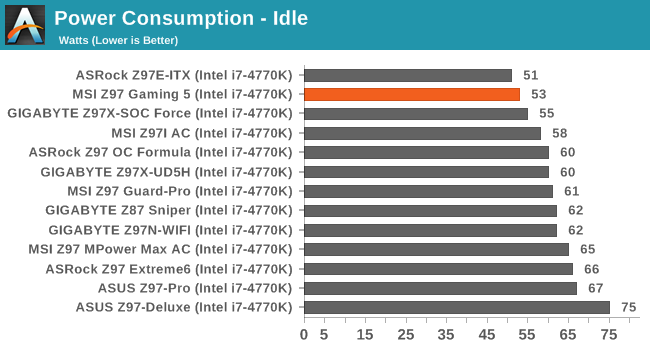
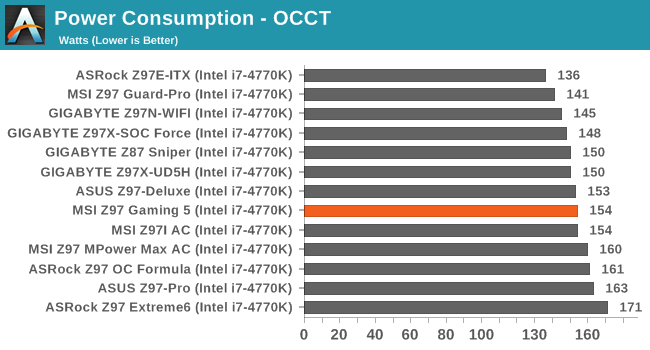
MSI’s idle power consumption numbers are nice and low, although this could potentially be pushed down further with Eco Center.
Windows 7 POST Time
Different motherboards have different POST sequences before an operating system is initialized. A lot of this is dependent on the board itself, and POST boot time is determined by the controllers on board (and the sequence of how those extras are organized). As part of our testing, we look at the POST Boot Time using a stopwatch. This is the time from pressing the ON button on the computer to when Windows 7 starts loading. (We discount Windows loading as it is highly variable given Windows specific features.)
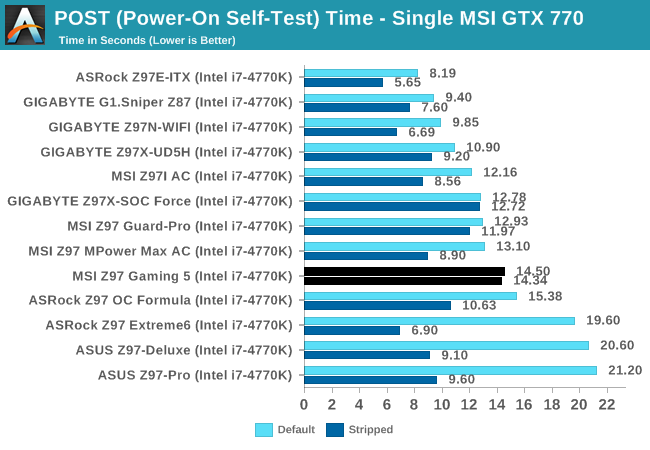
Z97 should be a good target for POST optimization, although the MSI clocks in at over 14 seconds in both stock and stripped timings.
Rightmark Audio Analyzer 6.2.5
Rightmark:AA indicates how well the sound system is built and isolated from electrical interference (either internally or externally). For this test we connect the Line Out to the Line In using a short six inch 3.5mm to 3.5mm high-quality jack, turn the OS speaker volume to 100%, and run the Rightmark default test suite at 192 kHz, 24-bit. The OS is tuned to 192 kHz/24-bit input and output, and the Line-In volume is adjusted until we have the best RMAA value in the mini-pretest. We look specifically at the Dynamic Range of the audio codec used on board, as well as the Total Harmonic Distortion + Noise.
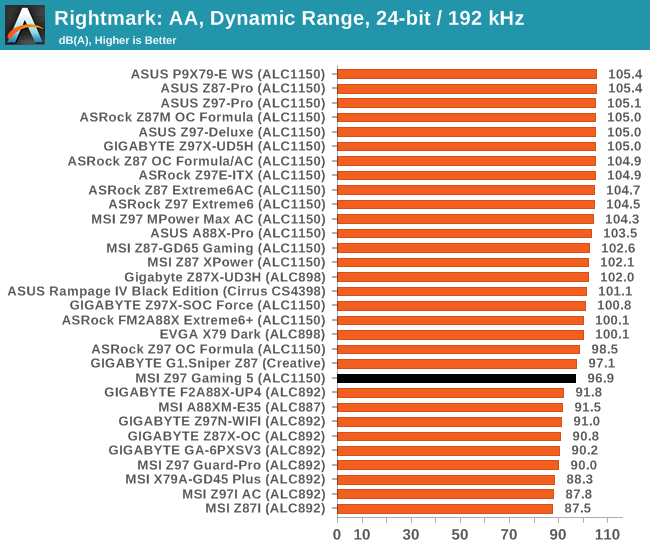
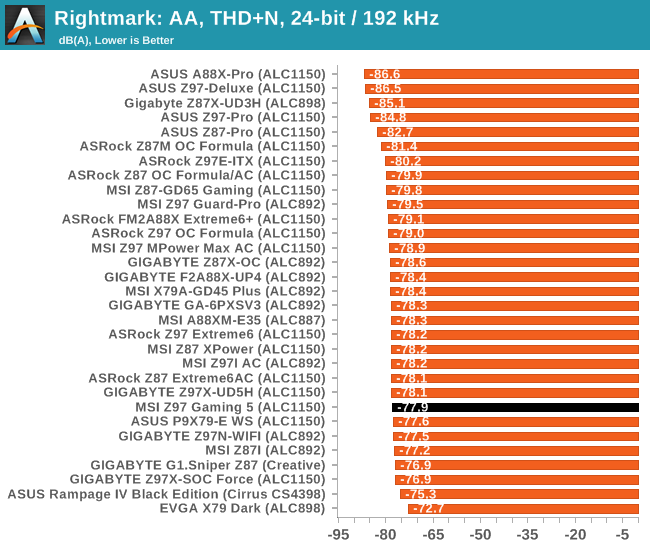
Similar to the Z97 OC Formula, the results of an enhanced ALC1150 on Z97 seem relatively low compared to Z87 testing. The use of extra tools such as Sound Blaster get in the way of our testing by artificially adjusting the signal, and even when turned off in the software they never seem to be turned off completely, hence why base ALC1150 models tend to do better in our test. We mentioned this to MSI before finishing up the review, and they showed us results nearer 104 dBA with the latest drivers which should be available online soon.
USB Backup
For this benchmark, we transfer a set size of files from the SSD to the USB drive using DiskBench, which monitors the time taken to transfer. The files transferred are a 1.52 GB set of 2867 files across 320 folders – 95% of these files are small typical website files, and the rest (90% of the size) are small 30 second HD videos. In an update to pre-Z87 testing, we also run MaxCPU to load up one of the threads during the test which improves general performance up to 15% by causing all the internal pathways to run at full speed.

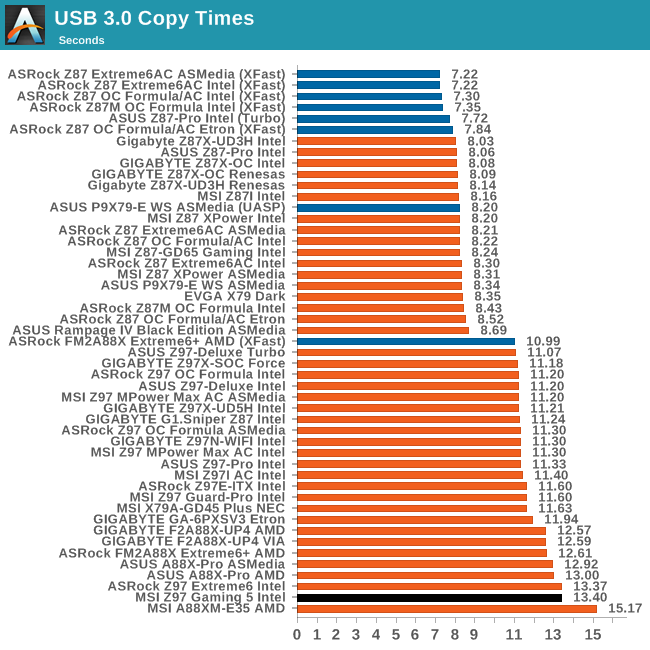
Every so often, MSI’s USB tests seem to be slower than everyone else. I am not sure why that is. Sometimes motherboard manufacturers will suggest different BIOS settings for when things are tested, but as a general rule at AnandTech I ignore those completely. MSI doesn’t offer such suggestions, but the results speak for themselves: a drop in USB 2.0 and USB 3.0 copy speed.
DPC Latency
Deferred Procedure Call latency is a way in which Windows handles interrupt servicing. In order to wait for a processor to acknowledge the request, the system will queue all interrupt requests by priority. Critical interrupts will be handled as soon as possible, whereas lesser priority requests such as audio will be further down the line. If the audio device requires data, it will have to wait until the request is processed before the buffer is filled.
If the device drivers of higher priority components in a system are poorly implemented, this can cause delays in request scheduling and process time. This can lead to an empty audio buffer and characteristic audible pauses, pops and clicks. The DPC latency checker measures how much time is taken processing DPCs from driver invocation. The lower the value will result in better audio transfer at smaller buffer sizes. Results are measured in microseconds.
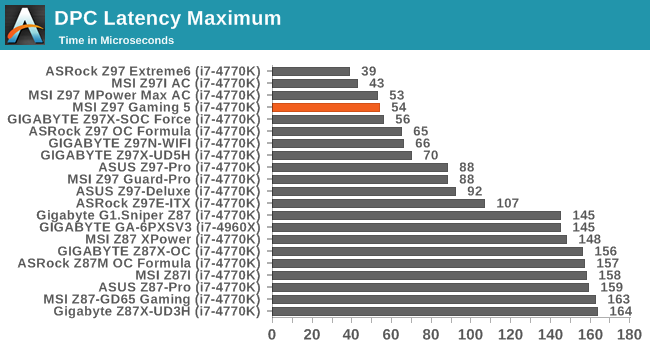
To counterbalance the USB speed issue, the MSI Z97 Gaming 5 does particularly well in our DPC Latency tests. In fact three of the top four positions in this benchmark are populated by MSI.











45 Comments
View All Comments
redwolfe98 - Tuesday, October 7, 2014 - link
the z97 boards are new.. they are not outdated..gammaray - Monday, October 6, 2014 - link
Would have been nice to see the Z97gaming5 compared with Z87 Msi Gd65, if it's worth it to upgrade at all...Cellar Door - Monday, October 6, 2014 - link
m2 SATA would by my only reason why I would buy this board over the z87-gd65(which I have been using for the last year). gd65 has been super solid for me, it OC very well and is super stable, my only issue with it are the bios 'broken' cpu header fan controls.ruthan - Monday, October 6, 2014 - link
No digital sound out, so im not interested.nos024 - Monday, October 6, 2014 - link
HDMI is digital sound out. Likewise USB can be considered digital sound out. Maybe you meant optical out?Antronman - Monday, October 6, 2014 - link
How can this be called a gaming motherboard without an intel port?The_Assimilator - Tuesday, October 7, 2014 - link
How this can be called a "gaming motherboard" when it has VGA output is beyond me.As for the article, "Compared to the Guard Pro, the Gaming 5 gets... HDMI rather than DisplayPort..." that's effectively a downgrade.
spidey81 - Tuesday, October 7, 2014 - link
Last time I checked, most "gamers" used a discrete GPU, making video ports on the motherboard redundant. The Guard Pro seems to be targeted at a more budget overclocking market. Even then, the only time I ever use an onboard graphics output is for functionality testing. And I'm pretty sure most users that have a system primarily used for gaming will attest to the same.The_Assimilator - Wednesday, October 8, 2014 - link
How many people using a VGA monitor are going to be buying a "gaming" motherboard anyway? VGA-out was acceptable on Z68, questionable on Z77, stupid on Z87, and is pants-on-head retarded on Z97. It doesn't belong on Z-series boards - put the HDMI and DisplayPort above the DVI port, and you free up tons of IO panel space for more useful things, like additional USB ports.C'DaleRider - Tuesday, October 7, 2014 - link
Oh well, it's an MSI board, a brand I avoid like the plague these days. I used to buy some MSI components and had great luck with their Lightening gpus. But I'm now stuck in MSI RMA hell, awaiting a third RMA on a gpu that's come back twice in worse shape than when it was sent out. Original failed in 5 weeks, replacement was fubar'd out of the box, the second at least shows something on the monitor but still artifacts, even while just idling. Third time's the charm.....maybe. And if I ever get a working gpu back from MSI, it's for sale immediately and will be my last MSI adventure.